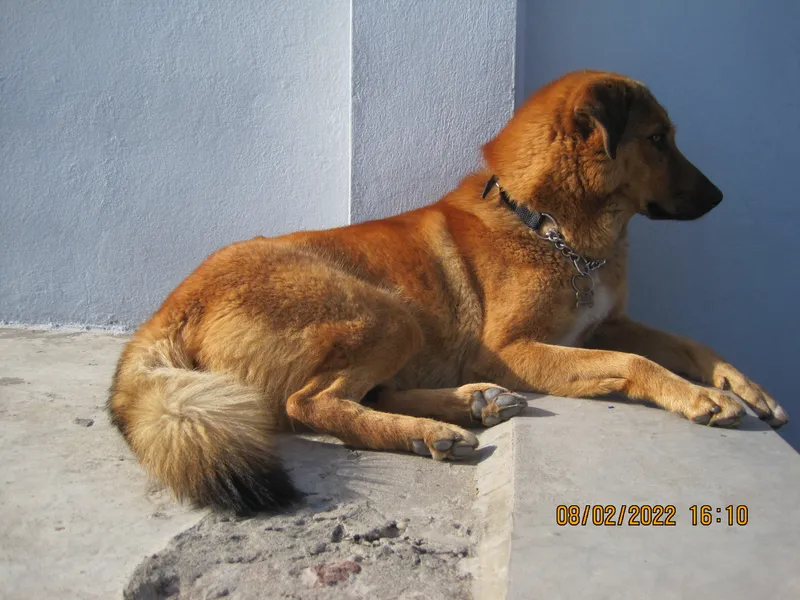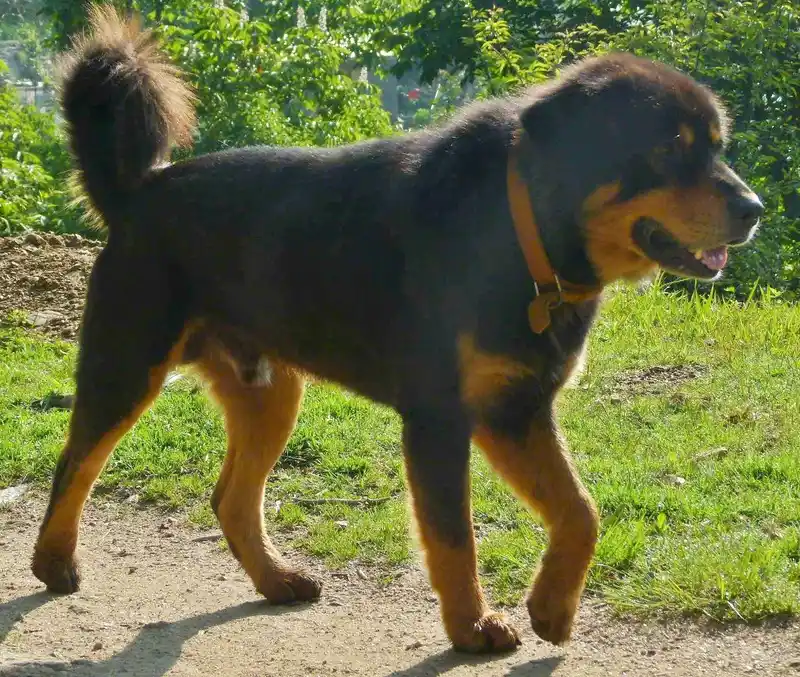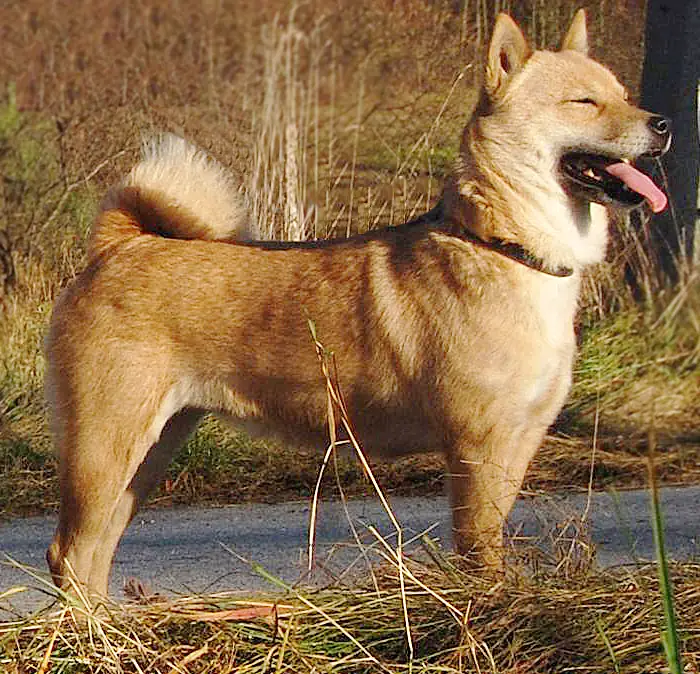Canadian Eskimo Dog
The Canadian Eskimo Dog is a loyal and intelligent working breed, known for its strength and endurance. With a rich history as a sled dog, they thrive in cold climates and require ample exercise. Their affectionate nature makes them great companions, though they need proper training due to their strong prey drive.
Overview
🐕Breed Overview
✨Key Traits
💡What Makes Canadian Eskimo Dog Special
Canadian Eskimo Dogs are characterized by their impressive strength and endurance, making them well-suited for rigorous activities. Their thick, double coat provides insulation against the cold, and their erect ears and feathered tails are typical of spitz breeds.
They are intelligent and trainable, often excelling in dog sports and obedience training. Their strong work ethic and desire for tasks make them ideal companions for active individuals or families.
Despite their independent nature, they are affectionate and enjoy being part of family activities.
The Canadian Eskimo Dog is a remarkable breed with a rich history and a unique set of characteristics that make it one of North America's oldest and rarest indigenous dogs. Originating from the Arctic regions, this powerful and athletic breed was historically used by the Inuit people for transportation and hunting. With a striking appearance reminiscent of wolves, the Canadian Eskimo Dog boasts a thick, dense coat that protects it from the harshest of climates.
Their loyalty, intelligence, and strong work ethic make them exceptional companions for active families and individuals who can provide the exercise and mental stimulation they require. Despite their declining numbers, efforts are underway to preserve this breed, ensuring that their legacy continues. Living with a Canadian Eskimo Dog means embracing an active lifestyle, as they thrive on rigorous exercise and enjoy participating in dog sports.
Their affectionate nature and deep bond with their owners make them wonderful family pets, although their strong prey drive necessitates careful training and socialization. As a breed that flourishes in cold climates, they are best suited for environments that allow them to express their natural instincts and enjoy outdoor activities. Whether pulling sleds or simply enjoying a romp in the snow, the Canadian Eskimo Dog is a breed that embodies resilience and companionship, making them a cherished addition to any home.
🎉Fun Facts
The Canadian Eskimo Dog is one of the oldest indigenous dog breeds in North America.
Their thick double coat allows them to thrive in extremely cold temperatures.
They were historically used by the Inuit for hunting seals and pulling sleds in harsh Arctic conditions.
This breed has a strong prey drive and may enjoy foraging and hunting activities.
Breed Characteristics
Family & Friends
Good Behavior
Get Up & Go
Household Harmony
Temperament & Personality
✨Key Traits
🐕Core Temperament
The temperament of the Canadian Eskimo Dog is a blend of loyalty, intelligence, and bravery. They are protective of their families and can be reserved around strangers, making them effective watchdogs.
Their affectionate nature allows them to bond closely with their owners, and they often enjoy spending time with children. However, their strong prey drive and independent spirit may require careful training and socialization to ensure they interact well with other pets and unfamiliar people.
Overall, they are adaptable and thrive in environments that allow them to express their natural instincts.
💫Personality Profile
The Canadian Eskimo Dog is known for its loyalty and intelligence, forming strong bonds with its owners. They are alert and protective, making them excellent watchdogs.
Their affectionate nature allows them to be gentle companions, especially with children. However, their strong prey drive may lead them to chase smaller animals, requiring careful supervision and training.
These dogs are highly energetic and thrive in active environments where they can engage in physical activities. They can be vocal, often barking to alert their owners of any changes in their surroundings.
🔊Vocal Tendencies
Canadian Eskimo Dogs are known to be vocal, often barking to alert their owners of strangers or changes in their environment. Their barking can vary from moderate to frequent, especially if they sense something unusual.
While they are not excessively noisy, their alertness makes them prone to vocalizations, which can be managed through training and socialization. They may also howl or make other sounds typical of spitz breeds, adding to their expressive communication style.
Affection & Social Traits
Energy & Activity
Communication Style
Care Requirements
🏃♂️Exercise Requirements
Daily Exercise
The Canadian Eskimo Dog requires a significant amount of exercise due to its working dog heritage. Ideally, they should engage in at least 90 to 120 minutes of vigorous activity each day.
This can include activities such as running, pulling sleds, or participating in dog sports like carting and skijoring. Puppies should be introduced to exercise gradually, with short play sessions that increase in duration as they grow.
Adult dogs thrive on high-intensity workouts that challenge their physical and mental capabilities. Insufficient exercise can lead to behavioral issues such as destructive tendencies, anxiety, and obesity, as these dogs are bred for hard work and require stimulation to remain happy and healthy.
Preferred Activities
🏠Living & Adaptability
Space Requirements
Canadian Eskimo Dogs thrive in spacious environments where they can roam and engage in physical activities. Ideally, they should have access to a large, securely fenced yard or open land.
While they can adapt to living in a home, they are not suited for apartment living due to their high energy levels and need for space to run. Owners in smaller living situations should ensure they can provide ample exercise and mental stimulation through regular outdoor activities and playtime.
Climate Preference
🍲Feeding Guide
Schedule
Food Types
Portion Size
Special Nutritional Needs
Canadian Eskimo Dogs may require a diet rich in protein and healthy fats to support their active lifestyle. It's essential to monitor their weight and adjust portions accordingly to prevent obesity, which can be a concern in less active dogs. Regular veterinary check-ups can help identify any specific dietary needs or sensitivities.
✨Grooming Requirements
Grooming Overview
The Canadian Eskimo Dog has a thick double coat that requires regular grooming to maintain its health and appearance. During shedding season, which occurs once a year, daily brushing is necessary to manage loose fur and prevent matting.
At other times, brushing once or twice a week is sufficient to keep the coat healthy. Bathing should be done as needed, typically every few months, to avoid stripping the coat of its natural oils.
Essential grooming tools include a slicker brush, undercoat rake, and comb to effectively manage the dense fur.
Care Schedule
Brush 1-2 times a week; daily during shedding season; bathe as needed.
Health Profile
⚕️Health Care
Regular health care is essential for maintaining the lifespan of a Canadian Eskimo Dog. Routine veterinary check-ups, vaccinations, and preventive treatments can help detect and address health issues early.
Owners should also be vigilant about dental care, as dental problems can affect overall health. Providing a balanced diet, regular exercise, and mental stimulation contributes to the dog's well-being and longevity.
Health Issues Overview
⏳Average Lifespan
Genetic Factors
Genetics significantly impact the lifespan of the Canadian Eskimo Dog, with hereditary health issues being a concern. Responsible breeding practices that focus on genetic diversity can help mitigate the risk of inherited conditions.
Potential owners should seek breeders who conduct health testing for common genetic issues, such as hip dysplasia and PRA, to ensure they are selecting a healthy puppy. Understanding the breed's genetic background can aid in making informed decisions about health management and care.
Living Conditions
The lifespan of a Canadian Eskimo Dog can be influenced by various environmental factors, including climate, living conditions, and social interactions. These dogs thrive in cold climates, where they can engage in physical activities and enjoy outdoor play.
A secure and spacious living environment allows them to exercise freely, which is crucial for their physical and mental well-being. Social interactions with humans and other dogs also play a vital role in their happiness and longevity.
Providing a stimulating environment with regular exercise can help promote a longer, healthier life for these dogs.
🏥Common Health Issues
Hip Dysplasia
Warning Signs
🔬Diagnosis
X-rays and physical examination by a veterinarian.
💊Treatment
Surgery or medication may be required in severe cases.
📝Management Tips
Maintain a healthy weight, provide joint supplements, and avoid excessive exercise on hard surfaces.
Progressive Retinal Atrophy (PRA)
Warning Signs
🔬Diagnosis
Veterinary eye examination and genetic testing.
💊Treatment
No cure; management focuses on adapting the dog's environment.
📝Management Tips
Regular eye check-ups and monitoring for vision changes.
Patellar Luxation
Warning Signs
🔬Diagnosis
Physical examination and X-rays.
💊Treatment
Surgical correction may be necessary in severe cases.
📝Management Tips
Maintain a healthy weight and provide joint supplements.
🛡️Preventive Care
🔬Hip Evaluation
Hip Evaluation assesses the hip joints for dysplasia and other abnormalities, crucial for preventing joint issues.
📅 Annually after 2 years of age.
🔬Eye Examination
Eye Examination checks for hereditary eye conditions, including PRA, ensuring early detection and management.
📅 Every 1-2 years, or as recommended by a veterinarian.
🔬Patellar Evaluation
Patellar Evaluation assesses the kneecaps for luxation, important for maintaining mobility and comfort.
📅 Annually after 1 year of age.
Training
🧠Intelligence & Trainability
💪Work Drive
Canadian Eskimo Dogs possess a high work drive, stemming from their history as sled dogs and hunters. They thrive when given tasks to perform, whether it's pulling sleds, participating in dog sports, or engaging in activities that challenge their physical and mental abilities.
This need for work is essential for their well-being, as it helps prevent boredom and associated behavioral issues. Owners should provide regular opportunities for these dogs to engage in meaningful activities that align with their instincts and energy levels.
⚠️Training Considerations
Canadian Eskimo Dogs can exhibit strong prey drives due to their history as hunters. This may lead to challenges in training, particularly around smaller animals.
They may also display stubbornness or independence, which can complicate obedience training. To overcome these challenges, consistent training methods that incorporate positive reinforcement are essential.
Socialization from a young age is crucial to help them learn to interact appropriately with other animals and people. Engaging them in activities that align with their natural instincts, such as pulling or running, can also help channel their energy positively.
📝Training Tips
Training a Canadian Eskimo Dog requires patience and consistency. Start with basic commands and gradually introduce more complex tasks.
Utilize positive reinforcement techniques, such as treats and praise, to encourage desired behaviors. Incorporating play into training sessions can keep them engaged and motivated.
Regular socialization with other dogs and people is vital to develop their confidence and reduce any wariness towards strangers. Given their intelligence, these dogs excel in obedience training and can participate in various dog sports, which can provide both mental and physical stimulation.
History & Heritage
📜Origin Story
The Canadian Eskimo Dog's origin is deeply intertwined with the Inuit culture, tracing back to the Thule people who first brought dogs to the Arctic. These dogs were essential for survival in the harsh conditions, serving as hunting partners and transportation aids.
Explorers in the early 19th century noted the breed's wolf-like appearance and remarkable abilities, which contributed to its reputation. The breed's decline began in the 1960s due to modernization and the controversial destruction of sled dog populations by authorities.
Conservation efforts have since been initiated to preserve this rare breed, which remains a symbol of the Inuit's historical relationship with their environment.
⏳Development History
The Canadian Eskimo Dog has a rich history that dates back over 4,000 years, originating from the Thule people who migrated to the Arctic regions. This breed is closely related to the Greenland Dog, with both breeds sharing similar characteristics and purposes.
Historically, the Canadian Eskimo Dog was bred for its strength and endurance, making it an essential companion for hunting seals and pulling sleds. The breed's development has been influenced by environmental factors and the needs of the Inuit, leading to its unique physical traits and temperament.
Despite its historical significance, the breed faced decline in the mid-20th century due to the introduction of snowmobiles and the impact of diseases, leading to a critical need for conservation efforts.
🛡️Purpose & Historical Role
Historically, the Canadian Eskimo Dog was utilized as a multi-purpose working dog, primarily for transportation and hunting in the Arctic. They were integral to the Inuit way of life, used for pulling sleds, hunting seals, and even tracking polar bears.
Their ability to forage for food and work in teams made them invaluable companions. Today, while their traditional roles have diminished, they are still used in some areas for sledding and as companions, reflecting their enduring legacy.
🏺Cultural Significance
The Canadian Eskimo Dog holds a significant place in the culture and history of the Inuit people of Canada. It is one of the oldest indigenous dog breeds in North America, having been utilized for thousands of years for transportation, hunting, and companionship in the harsh Arctic environment.
The breed's survival and role in Inuit culture reflect the deep bond between the dogs and their human counterparts, showcasing their importance in traditional ways of life. Today, the breed symbolizes resilience and adaptability, representing the heritage of the Inuit people and their connection to the Arctic landscape.
Conservation Status
This breed is endangered with low population numbers globally.









